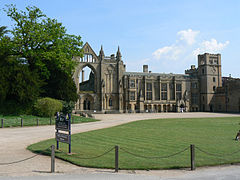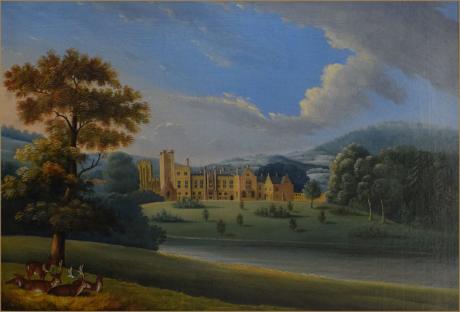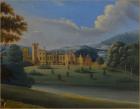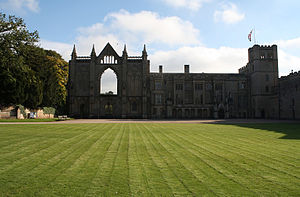indistinctly signed
Engraved ,1827 William M Fellows after R T Buttery and published by R T Buttery. The Engraving is Lettered below with the title and a dedication to the present owner Lt Col. Wildman by the artist; with producer names "R T Buttery Pinxit / Mr W M Fellows sc." Along the bottom "Published as the Act Directs, by R.T.Buttery Nottingham, Feby. 26th 1827"
The 6th Lord Byron, the Poet sold Newstead Abbey to his old school friend at Harrow, Colonel Thomas Wildman in December 1817, the sale being ratified in 1818, thus breaking the continued ownership of Newstead by the Byron Family for the first time in 263 years. This was an end of an era and the start of a new era of building or virtually the complete rebuilding of Newstead, so that the house we see today is largely his creation. Wildman was well respected in Nottinghamshire during his residency in the county from 1817-1859. The Wildmans were originally from Lancashire . The Wildman family had obtained Quebec Estate, a large sugar plantation in Jamaica, from William Beckford, who was having financial problems. The wealth generated from this plantation provided Wildman with the means to purchase Newstead Abbey in 1818 for £95,000 from a Mr. Clawton, who had bought it of Lord Byron for £14,000. The Abbey was owned by his friend and old schoolmate, Lord Byron who, like Beckford, was having financial difficulties. Byron had been trying to sell the Abbey since 1812. Of the sale, Byron's half-sister Augusta said Wildman had "soul enough to value the dear Abbey..."
Although Wildman's purchase ended almost four centuries of Byron family ownership of the Abbey, he was considered to be the man who saved Byron's home. He spent £100,000 restoring it, hiring the architect John Shaw to make improvements. He also amassed a large collection of Byron memorabilia there. He served as High Sheriff of Nottinghamshire for 1821-22. The Wildmans entertained many guests who wished to visit the home of Lord Byron, including Franz Liszt and Washington Irving. The Duke of Sussex visited annually for a six-week holiday with his chaplain. After Wildman's death, Louisa sold the Abbey to William Frederick Webb. From 1817 onwards Wildman was deeply involved in the complete restoration of the Newstead. He was an amateur architect and 2 of his designs for the Abbey survive, one for the south staircase . He employed the architect John Shaw 1776-1832 to carry out the remodelling of the house. In the interior the medieval undercrofts and ground floor spaces were restored and brought into use. The upper floors were considerably altered , bathrooms , water closests and colsa oil lighting were all installed. For some , possibly all the interior decoration of the principle rooms the brilliant contemporary decorator Thomas Willement collaborated with Shaw.
| Newstead Abbey | |
|---|---|
 |
|
|
|
Monastic foundation
The priory of St. Mary of Newstead, a house of Augustinian Canons, was founded by King Henry II of England about the year 1170,[1] as one of many penances he paid following the murder of Thomas Becket. Contrary to its current name, Newstead was never an abbey: it was a priory.
In the late 13th century, the priory was rebuilt and extended. It was extended again in the 15th-century, when the Dorter, Great Hall and Prior's Lodgings were added.The priory was designed to be home to at least 13 monks, although there appears to have been only 12 (including the Prior) at the time of the dissolution.
The Valor Ecclesiasticus of 1534 gave the clear annual value of this priory as £167 16s. 11½d. The considerable deductions included 20s. given to the poor on Maundy Thursday in commemoration of Henry II, the founder, and a portion of food and drink similar to that of a canon given to some poor person every day, valued at 60s. a year.
Despite the clear annual value of Newstead being below the £200 assigned as the limit for the suppression of the lesser monasteries, this priory obtained the doubtful privilege of exemption, on payment to the Crown of the heavy fine of £233 6s. 8d in 1537.
The surrender of the house was accomplished on 21 July 1539. The signatures attached were those of John Blake, prior, Richard Kychun, sub-prior, John Bredon, cellarer, and nine other canons, Robert Sisson, John Derfelde, William Dotton, William Bathley, Christopher Motheram, Geoffrey Acryth, Richard Hardwyke, Henry Tingker, and Leonard Alynson.
The prior obtained a pension of £26 13s. 4d., the sub-prior £6, and the rest of the ten canons who signed the surrender sums varying from £5 6s. 8d. to £3 6s. 8d.
The lake was dredged in the late eighteenth century and the lectern, thrown into the Abbey fishpond by the monks to save it during the Dissolution of the Monasteries, was discovered. In 1805 it was given to Southwell Minster by Archdeacon Kaye where it still resides.
Priors of Newstead
- Eustace, 1216
- Richard, 1216
- Robert, 1234
- William (late cellarer), 1241
- William, 1267
- John de Lexinton, resigned 1288
- Richard de Hallam, 1288
- Richard de Grange, 1293
- William de Thurgarton, 1324
- Hugh de Colingham, 1349
- William de Colingham, resigned 1356
- John de Wylesthorp, resigned 1366
- William de Allerton, 1366
- John de Hucknall, 1406
- William Bakewell, 1417
- Thomas Carleton, resigned 1424
- Robert Cutwolfe, resigned 1424
- William Misterton, 1455
- John Durham, 1461
- Thomas Gunthorp, 1467
- William Sandale, 1504
- John Blake, 1526
Sir John Byron of Colwick in Nottinghamshire was granted Newstead Abbey by Henry VIII of England on 26 May 1540 and started its conversion into a country house. He was succeeded by his son Sir John Byron of Clayton Hall. Many additions were made to the original building. The 13th century ecclesiastical buildings were largely ruined during the dissolution of the monasteries. It then passed to John Byron, an MP and Royalist commander, who was created a baron in 1643. He died childless in France and ownership transferred to his brother Richard Byron. Richard's son William was a minor poet and was succeeded in 1695 by his son William Byron, 4th Baron Byron. Early in the 18th century, the 4th Lord Byron landscaped the gardens extensively, and amassed a hugely admired collection of artistic masterpieces.
During the ownership of William, 5th Baron Byron, the Abbey suffered a downturn in fortunes. As a young man, William lavished money on the estate, building picturesque Gothic follies and staging glamorous mock navy battles on the lake. Continuing to take out loans and pursue his pleasures of horse-racing, gambling, and going to the theatre, he found himself financially reliant on a scheme of marrying off his only surviving son and heir to a wealthy heiress. The plan fell apart when his heir eloped with his cousin Juliana Byron, daughter of William's brother John Byron.
Though late 18th-century gossip attested that he ruined the estate, felled trees, and killed deer while hellbent on revenge, this is not the case – he simply had no money to pay his debts, and stripped the Abbey and estate of its artistic treasures, furniture, and even its trees, to quickly raise cash. Though he made thousands of pounds it was not enough to pay back the loans he had been taking out since his thirties, and there was no hope of restoring the Abbey to its former glory.
As well as outliving all four of his children William also outlived his only grandson, who was killed by cannon fire in 1794 while fighting in Corsica at the age of 22. The 5th Lord died on 21 May 1798, at the age of 75. Later, 19th-century myths attest that on his death, the great numbers of crickets he kept at Newstead left the estate in swarms. The title and Newstead Abbey were then left to his great-nephew, George Gordon Byron, then aged 10, who became the 6th Baron Byron and later the famous and notorious poet.
The young Lord Byron soon arrived at Newstead and was greatly impressed by the estate. The scale of the estate contributed to Byron's extravagant taste and sense of his own importance. However, no less impressive was the scale of problems at Newstead, where the yearly income had fallen to just £800 and many repairs were needed. He and his mother soon moved to the nearby town of Southwell and neither lived permanently at Newstead for any extended period. His view of the decayed Newstead became one of the romantic ruin, a metaphor for his family's fall:
Thro' thy battlements, Newstead, the hollow winds whistle;
Thou, the hall of my fathers, art gone to decay.
The estate was leased to the 23-year-old Henry Edward Yelverton, 19th Baron Grey de Ruthyn, from January 1803. The lease was for £50 a year for the Abbey and Park for five years, until Byron came of age. Byron stayed for some time in 1803 with Lord Grey, before they fell out badly.
In 1808, Lord Grey left at the end of his lease and Byron returned to live at Newstead and began extensive and expensive renovations. His works were mainly decorative, however, rather than structural, so that rain and damp obscured his changes within just a few years.
Byron had a beloved Newfoundland dog named Boatswain, who died of rabies in 1808. Boatswain was buried at Newstead Abbey and has a monument larger than his master's. The inscription, from Byron's poem Epitaph to a Dog, has become one of his best-known works:
Near this Spot Are deposited the Remains of one Who possessed Beauty Without Vanity, Strength without Insolence, Courage without Ferosity, And all the Virtues of Man without his Vices. This Praise, which would be unmeaning flattery If inscribed over Human Ashes, Is but a just tribute to the Memory of "Boatswain," a Dog Who was born at Newfoundland, May, 1803, And died at Newstead Abbey Nov. 18, 1808.
Byron had wanted to be buried with Boatswain, although he would ultimately be buried in the family vault at the nearby Church of St Mary Magdalene, Hucknall.
He was determined to stay at Newstead—"Newstead and I stand or fall together"—and he hoped to raise a mortgage on the property, but his advisor John Hanson urged a sale. This would be a preoccupation for many years and was certainly not resolved when Byron left for his Mediterranean travels in 1809. Upon his return to England in 1811, Byron stayed in London, not returning to see his mother who had been living in Newstead. She died, leaving him distraught at his own negligence of her. He lived again at the Abbey for a time but was soon drawn to life in London.
For the next few years, Byron made several attempts to sell the Abbey. It was put up at auction in 1812 but failed to reach a satisfactory price. A buyer was found, however, who offered £140,000, which was accepted. By spring 1813, though, the buyer, Thomas Claughton, had only paid £5,000 of the agreed down-payment. Byron was in debt and had continued to spend money on the expectation that the house would be sold. Negotiations began to degenerate and Byron accused Claughton of robbing the wine cellar. By August 1814, it was clear that the sale had fallen through, and Claughton forfeited what he had paid of the deposit. Byron was now without settled financial means and proposed marriage to the heiress Anne Isabella Milbanke. Claughton did return with new proposals involving a reduced price and further delays. Byron turned him down.
Letitia Elizabeth Landon's poem Lines Suggested on Visiting Newstead Abbey accompanies an engraving of Newstead Abbey after a painting by Thomas Allom (Fisher's Drawing Room Scrap Book, 1839). This poem is mainly a reflection on Byron and what it means to be a poet. Miss Landon may have visited Newstead Abbey on one of her visits to her uncle in Aberford, Yorkshire.
In July 1815, Newstead was once again put up for auction but failed to reach its reserve, bought in at 95,000 guineas. It was only during Byron's exile in Italy, in 1818, that a buyer was found.Thomas Wildman, who had been at Harrow School with Byron and was heir to Jamaican plantations, paid £94,500, easing Byron's financial troubles considerably.
Wildman too spent a great deal of money on the Abbey and its contents, restoring it to some greatness. The architect John Shaw Sr. designed new parts of the abbey for Wildman.
William Frederick Webb
In 1861, William Frederick Webb, African explorer, bought the Abbey from Wildman's widow. People including David Livingstone, Abdullah Susi, James Chuma and Jacob Wainwright all visited the Abbey at different times during the period Webb lived there. Under Webb, the chapel was redecorated, but the rest of the house remained largely unaltered. After his death in 1899, the estate passed to each of his surviving children and finally to his grandson Charles Ian Fraser. Fraser sold Newstead to local philanthropist, Sir Julien Cahn, who presented it to Nottingham Corporation in 1931.
The Abbey is owned, by Nottingham City Council, and houses a museum containing Byron memorabilia. It plays host to weddings and other events.
Robert Thomas Buttery, Nottingham 1824-1828, Market Place, Nottingham 1824, Park St, Nottingham 1825, Postern St, Nottingham 1828, 3 Commercial Buildings, Leeds 1832. Possibly 33 Greek St, London 1841, Woburn Buildings, Marylebone 1841. Artist, teacher of drawing and picture restorer.
The artist and restorer Robert Thomas Buttery (c.1805?-1865??) is not easy to place. Nor is it possible to be confident about his relationship with the better-known business of Charles Buttery (see above). What can be established is as follows.
In 1824 he was responsible for the design and publication of a colour aquatint engraved by Thomas Sutherland, when his address was given as Nottingham Market Place; the print was published in May 1824 with a dedication from Buttery to the Duke of Newcastle and it was published jointly with the printseller, R. Cocher, from 109 Newgate St. Buttery published a further Nottinghamshire view, Newstead Abbey, in 1827. In Nottingham directories, R.T. Buttery was listed as a teacher of drawing in Park St, Nottingham in 1825 (a solicitor, John Buttery, was also recorded in Nottingham) and as Robert Thomas Buttery, artist, in Postern St in 1828, but he does not feature in 1832.
By 1832 he was working in Leeds, where he advertised as R.T. Buttery, artist, at 3 Commercial Buildings, referring to his ‘many years study and practice in the art of restoring old paintings’ and to his practice in Yorkshire for ‘upwards of three years’, during which he had restored collections in both the East and West Ridings (Leeds Intelligencer 23 February 1832; last advertisement 15 March 1832). Also in 1832, jointly with G.F. Buttery, he cleaned and lined Peter Casteels’s Flowerpiece, c.1720, which is inscribed in ink on the lining: ‘R.. T.. & G.. F.. Buttery/ Artist/ Cleaners Liners &c[?]/ 1832’ (private coll., information kindly supplied by Kiffy Stainer-Hutchins, November 2013). Interestingly, it was in Leeds that Charles Buttery’sfirst child, Margaret Elizabeth, was christened in 1833.
It is possible that R.T. Buttery can be identified with the Robert Buttery (b. c.1805) who can be found in census records as an artist, in 1841 at Woburn Buildings, Marylebone, age 35 (ages were rounded down to the nearest five in this census), with his wife Margaret and perhaps his mother, Anna Buttery, age 65, and in 1851 as a visitor to John Thomas in Tottenham, when he was described as a widower, age 46, born Worcester. Robert Buttery, picture restorer, can be found at 33 Greek St, Soho, in the 1841 London Post Office directory, but was immediately preceded and followed at this address by Charles Buttery (qv). A Robert Thomas Buttery died in Southwark in 1865.









